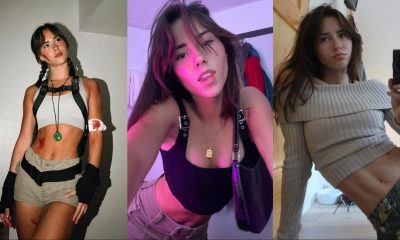Health
Varicose Veins: Causes, Symptoms, Diagnosis, And Treatment
Varicose veins, also known as varicosities, are veins that expand, dilate, and overfill with blood. Varicose veins are bluish-purple or red in hue and seem swollen and raised. They often cause discomfort and pain. They form when the valves in the veins fail, stopping blood from flowing as freely as it should. In certain individuals, varicose veins hurt and cause severe pain and suffering.
Convoluted, dilated vein segments that are linked to valvular incompetence characterize varicose veins. Defective valves that allow blood to pass from the deep to the superficial venous systems cause edema. Venous hypertension and dilation of the superficial venous system develop as a consequence of this illness.
The condition is very prevalent, particularly among women. Varicose veins affect roughly a quarter of the population. These are most often seen in people’s lower legs. A varicose vein may burst in extreme instances, causing a varicose ulcer to develop on the skin’s surface. These will need medical attention. Varicose veins ICD 10 (I83.81) is a billable condition with therapy that may need self-care methods or medical treatments to seal or eliminate veins.
Causes
It may form as a consequence of weak or broken valves in the veins themselves. Arteries transport blood from the heart to the rest of the body’s tissues, while veins return blood from the rest of the body to the heart, enabling for the re-circulation of blood throughout the body. The veins in the legs must resist gravity to transport blood back to the heart.
Contractions of the lower leg muscles serve as pumps, and the flexibility of the vein walls assists in the return of blood to the heart. When blood travels toward the heart, small valves in the veins open and shut to prevent blood from flowing backward into the heart. Because of the weakness or damage to the valves of a vein, blood may flow reverse and collect in the vein, causing strain or twisting of the veins.
Following are some of the risk factors of varicose veins:
- Age: As individuals become older, they are more likely to develop varicose veins. Vein valves that assist in controlling blood flow get increasingly worn and damaged as you get older, making it more difficult to breathe and move about. With continued wear and tear, the effectiveness of your blood vessels is reduced. Some blood may be forced back into your veins, where it may collect, rather than up to your heart, as it normally should.
- Gender: Women are more susceptible to this condition than men are. Female hormones, which have a propensity to relax vein walls, may have a role in the development of such veins before menstruation, during pregnancy, and after menopause. Hormonal treatment, such as birth control tablets, has been shown to increase the risk of developing varicose veins in women. Varicose veins in the testicles are termed varicocele, which is an expansion of the veins inside the loose bag of skin that surrounds the testicles (scrotum).
- Pregnancy: the amount of blood in the body rises significantly. While this shift is beneficial to the infant’s development, it may have an unintended consequence: larger veins in the legs. Hormonal changes linked to pregnancy may also be a factor.Vulvar varicosities are varicose veins on the female vaginal area (vulva and labia). They are most common in pregnancy.
- Long durations of standing or sitting: The blood circulation is harmed if you stay in the same position for an extended period.
Symptoms
These are distorted veins that are usually manifested on the legs. You may have heaviness and discomfort in the region of the enlarged veins in addition to varicose vein pain and edema. Some people suffer from edema and discoloration because of this illness. Because of the amount of blood lost via the veins, ulcers are a possibility in severe instances.
In the majority of cases, there is no pain; nevertheless, there are many signs and symptoms of varicose veins, including:
- Twisted and swollen veins
- Veins with dark discoloration
Diagnosis
Your doctor will inspect your legs and visible veins while you sit or stand to identify varicose veins. They may inquire about any discomfort or symptoms you are having. Your doctor may also recommend an ultrasound to evaluate your blood flow. This noninvasive diagnostic technique uses high-frequency sound waves to evaluate your health. This enables your doctor to keep track of the blood flow via your veins.
A venogram may be performed to study your veins in more detail, depending on their location. During this procedure, your doctor will inject a specific dye into your legs and then take X-rays of the affected region. X-rays are taken. Ultrasounds and sonograms may help determine whether your swelling legs and ankles are the result of another disease, such as a blood clot or a blockage.
Treatment
To get rid of varicose veins, it is important to exercise. For varicose veins pain relief, it is suggested to elevate the legs. Working out to stretch your calf muscles many times a day may also be beneficial. Make sure to stretch your feet often while traveling for extended periods in tight places with little leg room. varicose veins cream can also be used to soothe pain and improve their appearance.
The best treatment for varicose veins includes compression socks and stockings. These provide sufficient pressure on your legs to facilitate blood flow to your heart. They alleviate edema. If varicose veins cause pain or are detrimental to your health, your doctor may suggest invasive surgery for varicose veins removal. For vein ligation and stripping operations, anesthesia is needed.
When to See a Doctor
If you have varicose veins and have any of the following symptoms, see your doctor: Legs bloated and in excruciating pain. Your legs may feel heavy or achy at the end of the day or after physical exercise. It is crucial to see a doctor at the initial stage to prevent complications like burst varicose veins and bleeding varicose veins.





 Technology4 weeks ago
Technology4 weeks ago10 Best Generative AI Tools to Scale Your Business in 2024



 Games2 weeks ago
Games2 weeks agoA Brief History of Solitaire: From Cards to Computers



 Model3 weeks ago
Model3 weeks agoKatelyn Ernst: Bio, Age, Lifestyle, Career, Hair & Eye Color, Net Worth



 Technology2 weeks ago
Technology2 weeks agoHow To Enhance Your Learning With Duolingo Podcasts?



 Technology5 days ago
Technology5 days agoThe Website Design Workshop: Crafting User-Centric Sites

You must be logged in to post a comment Login